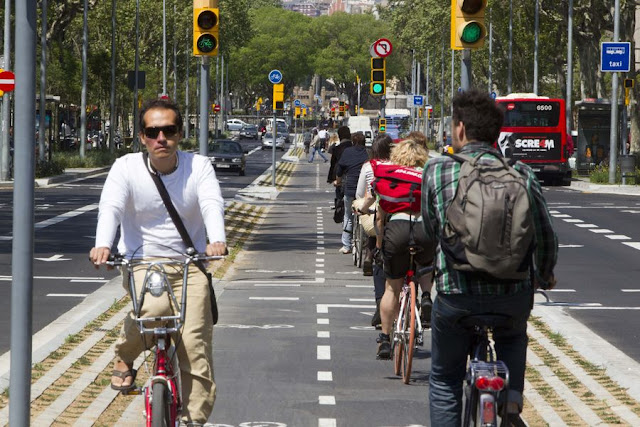Hyvää torstaita (thursday_dijous) kaikille!
Helsinki and Barcelona are two of the top twenty cities for cycling, according to the studies that, every year, the Copenhagenize Design Company,, an entity created to help spread, improve and extend the culture and use of this way of transport. _Hèlsinki i Barcelona són dues de les vint millors ciutats per anar en
bicicleta, segons el balanç que fa, cada any, la Copenhagenize Design Company, una entitat creada per ajudar a difondre, millorar i extendre
la cultura i la utilització d'aquest mitjà de transport.
Finland's capital is in the tenth position of the ranking and rises seven positions in relation to last year chart. With an ambitious objective of being the most important city in the world in terms of sustainable transport, Helsinki, along with Paris, has established a quota so that 15% of intercity transport will be based on bicycles next year. Currently, the percentage is 11%. _La
capital de Finlàndia es situa en la desena posició de la classificació i
puja set llocs en relació amb l'any anterior. Amb un ambiciós objectiu
de ser la ciutat més important del món pel que fa a transport
sostenible, Hèlsinki, juntament amb París, ha establert una quota per
tal que el 15% del transport interurbà estigui basat en bicicletes l'any
vinent. Actualment el percentatge és de l'11%.
With regard to Barcelona, the Catalan capital drops two positions and stands at number 13. Despite the decline, Barcelona continues to be an example of innovation in urban mobility. With a constantly expanding transport network and a plan to a better incorporation of bicycles through many pilot programs, Barcelona occupies a place in the Top 20 of the world ranking for the eighth consecutive year. _Pel que fa a Barcelona,
la capital catalana baixa dues posicions i se situa al lloc número 13.
Tot i el descens, Barcelona segueix sent un exemple d'innovació en
mobilitat urbana. Amb una xarxa de transport en constant expansió i un
pla per incorporar millor les bicicletes a través de nombrosos programes
pilot. Barcelona, així, continua ocupant un lloc al Top 20 del rànquing mundial per
vuitè any consecutiu.
The
top positions in the ranking are occupied by Copenhagen, Amsterdam,
Utrecht, Antwerp, Strasbourg, Bordeaux, Oslo, Paris and Vienna. _Les primeres posicions de la classificació estan
ocupades per Copenhaguen, Amsterdam, Utrecht, Anvers, Estrasburg,
Bordeus, Oslo, París i Vienna.
Nauttikaa! Enjoy_gaudiu!
MOI, MOI!























